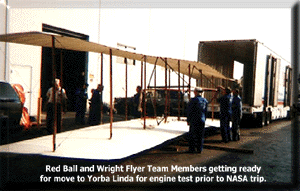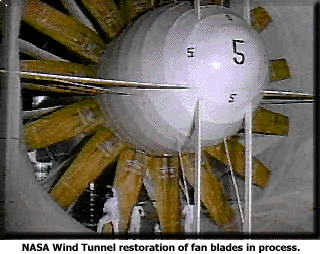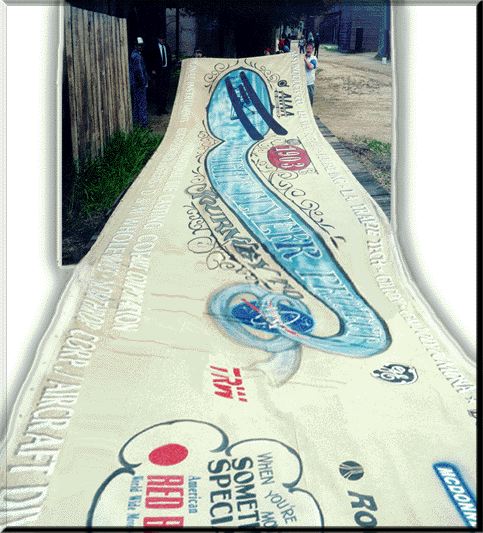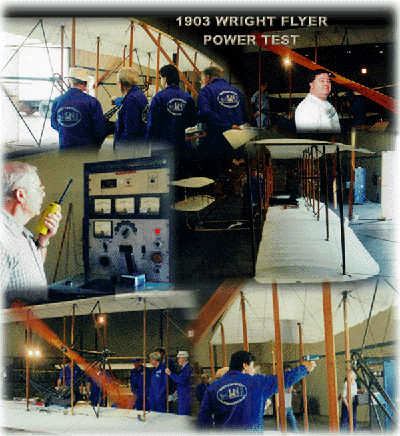

|
But, most importantly, preparations to take our airplane to
NASA Ames Research Center assumed a new
urgency as the wind tunnel test loomed closer on the calendar. In order to
insure a smooth and efficient test, numerous "pre-test" tests must be completed.
This is due to the sheer size of the model and the wind tunnel - once we are
installed, our airplane will be suspended over 32 feet above the ground!
"Bic" Bickford of International Die Casting has been extraordinarily
generous to us, donating several hundred square feet of workshop space for
the past several years. However, like any bird yearning for its wings, our
airplane has outgrown its nest. Once again, we had to carefully load the
Flyer into a moving van, and ship it to its temporary home at the
Able Corp. in Yorba Linda California. Here is where we plan to perform the
checkout of the engine, actuation and data acquisition systems. This is also
where we held our Open House in November, which was attended by Astronaut
Frank Borman and several hundred others.

|
Our immediate schedule is
being paced
by NASA's work to
upgrade the wind tunnel in which we want to test our Flyer.
The National Full Scale Aerodynamic Complex is actually
two wind tunnels
in one: one leg has a 40ft
x 80ft test section in which we will test,
the other leg is the 80ft
x 120ft test section. In order to improve
the facility's data quality, the tunnel was taken off-line in 1995 for
acoustic treatment and general maintenance. A major component of this
preventive maintenance is the restoration & refurbishment of the tunnel
drive system - the six electric motors and their fan blades which produce
the required air velocity for tests.
Special thanks to Jim & Paul Ecker, two artists who donated their time
and talents to give us a little publicity as we trek north from Los Angeles
to Moffett Field. Once the airplane is safely tucked inside our two trucks
provided by DeVries in Spokane and American Red Ball out of Indiana, this
banner, sponsored by Devries Moving and Storage will be placed on one of
the trucks for the 8 day "Wright Flyer Project - Journey to NASA".

|

|
The instrumentation specialists are busy connecting their inclinometers, pots & LVDT's to the computer for a test the data collection system. Water lines have been hooked to the motor for cooling, as well as thick cables to provide the required power. Someone laments the fact that our airplane, which until now has been in pristine condition, is becoming cluttered with so many cables and instruments that wouldn't be required for flight. One of the more experienced test engineers says it finally is beginning to look like a wind tunnel model. It takes all kinds...
The first run didn't last very long. No one wants to push too hard immediately. One of the drive chains developed a kink in it that needs to be fixed, and the quick disconnect on the shaft that connects the motor to the chain drive has developed a slip. Both should be easy to fix.
Finally, after a mid-afternoon pizza break (you can only push volunteer labor so hard without food), Howard Ward, president of Able Corp and the man who is donating his warehouse for the test, calls for power to be applied. The props start to turn, the ropes become taunt, and and we begin nervously circling the airplane looking for anything that might be working itself loose. Jack Cherne, project chairman, confers with Craig Hange of NASA Ames who is here to witness the test. One hour is the agreed upon duration - any less and we haven't proved that our model will stand up to the rigors of extended running; any more and we'd be unnecessarily risking our airplane.
So, for an hour we monitor the health of our replica, checking bearing temperatures, chain slack, RPM, and the motor temperature. One of the aerodynamicists walks around the airplane with a long piece of string tied to a stick to trace the airflow into and out of the propellers. Our structural dynamicist carefully places a full cup of water on the wing to check for vibrations. It doesn't spill - we have a stable structure! Anyone not checking on the model seems to have a camera or video.
When then motor is eventually shut down, we swarm to the airplane to check for damage. There is some, but it is minor: some bolts have worked their way loose (these will have to be safety wired prior to our wind tunnel test), and the chain tube that guides our chain up from the motor to the propeller and back again has cracked due chain vibration. This can all be fixed prior to shipping the Flyer north to Ames next month. All in all, a good test.
Copyright © 1996-2003, AIAA Wright Flyer Project, all rights reserved.